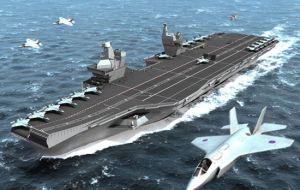MercoPress. South Atlantic News Agency
Portsmouth prepares to receive the Royal Navy’s biggest warships ever
 The Queen Elizabeth carrier is expected to arrive in Portsmouth in 2016
The Queen Elizabeth carrier is expected to arrive in Portsmouth in 2016 Britain’s Portsmouth Naval Base is preparing to be the home of the biggest warships ever built for the Royal Navy. A specialist rig began six weeks of drilling on Friday, sampling the seabed in the harbour and in the Solent.
The tests will pave the way for major dredging work in a couple of years' time to allow the 65,000-tonne HMS Queen Elizabeth and Prince of Wales aircraft carriers to safely and easily enter the harbour.
The two flagships are 10.000 tons heavier than the last traditional-style carriers to serve the Royal Navy - HMS Ark Royal and HMS Eagle, which were both decommissioned in the 1970s - and much larger than any current warship based in Portsmouth.
The existing channel used by ships needs to be widened and deepened to accommodate the new carriers. The berths in the base itself also need to be excavated and a suitable turning circle provided in the north of the harbour - the draught (the depth of a loaded vessel in the water taken from the level of the waterline to the lowest point of the hull) of the sisters will be 36 feet (11m).
Survey work was carried out a decade ago - not least on the wreck site of the Mary Rose to ensure that everything of historical importance had been recovered from Henry VIII flagship.
In addition, a detailed environmental analysis of the harbour and its approaches was carried out in 2004, while the bridge simulator at HMS Collingwood has been adapted to test the new route to prove that the carriers can enter or leave the harbour in a range of tidal and weather conditions - so far more than 180 simulated arrivals and departures have been conducted.
Captain Iain Greenlees, who is in charge of the transformation project ahead of the ships' arrival, said the work by rig 'Deep River' would build on existing understanding of the geology of the harbour and its approaches:
“Work so far has identified the route which balances best navigational safety, the lowest environmental impact and cost,” he explained.
“The analysis of these final boreholes will complete our detailed understanding of the work that will be required and allow us to apply for final approvals - and run a competition for the work.”
The Queen Elizabeth is due to be launched in 2014 and will arrive in her future home of Portsmouth two years later; the Prince of Wales is due to join the fleet towards the end of the decade.
Next year work will begin to replace telephone cables between Southsea and the Isle of Wight, followed in 2014-15 by major dredging work. Captain Greenlees said around three-and-a-half million tonnes of seabed need to be moved.
The Deep River rig will drill 27 bore holes to a depth of 104 feet (32m) along various parts of the proposed route. The rig will be brightly lit and will be operating 24-hours-a-day.
It will need to dig five holes in the harbour entrance which will cause some minor delays, but Queen's Harbour Master Commander Nigel Hare said every effort has been made to keep disruption to a minimum - including suspending work at weekends - and 50 residents of Spice Island were being informed of the impending work.
Commander Hare added that the work is very important in the run-up to the new carriers arriving in Portsmouth.
“It's hoped that harbour users and local residents will understand the relatively short-term inconvenience of the rig set against the much longer-term benefit of the project to the harbour - and the city”.




Top Comments
Disclaimer & comment rules-

-

-

Read all commentsA most powerful ship indeed,
Feb 06th, 2012 - 10:05 pm 0A projection of power that will send the message, that Britain,
Can and will, if needed,
A fine ship in deed, alas their will always be some that are envious and think it provocative .
Then let us prevoke with 65'000 tonnes up the river plate ! Boom Boom !
Feb 06th, 2012 - 10:41 pm 0New planes
Feb 06th, 2012 - 11:12 pm 0http://www.baesystems.com/Sites/Taranis/Newsroom/autoGen_110612124240.html
new ship
http://www.baesystems.com/Sites/Taranis/Newsroom/autoGen_110612124240.html
type 26.
http://www.baesystems.com/Sites/Taranis/Newsroom/autoGen_110612124240.html
HMS Astute
http://www.baesystems.com/Sites/Taranis/Newsroom/autoGen_110612124240.html
its all coming together, just nicely, thank you .
plymouth / portsmouth / falsane
all very busy, very soon .
Commenting for this story is now closed.
If you have a Facebook account, become a fan and comment on our Facebook Page!